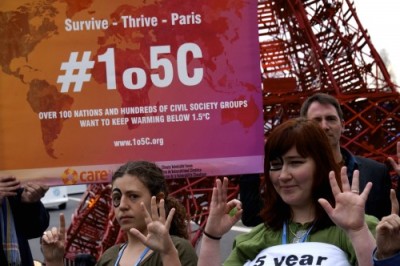COP 21 Battle over 1.5 Degree Global Target
The Contradictory Impulses in the Global Climate Negotiations
 The Paris Conference of the Parties (COP) 21 negotiations are, not surprisingly, coming down to the wire with a number of contentious issues still unresolved. One issue that has surprised, impressed and puzzled me is the debate about whether the agreement should incorporate a goal that the global community work to limit temperature increases to 1.5 C by the end of the century rather than 2.0 C. France has circulated language in the latest text committing the parties to holding global temperature averages to “well below 2 degrees Celsius above pre-industrial levels and to pursue efforts to limit the temperature increase to 1.5C.”
The Paris Conference of the Parties (COP) 21 negotiations are, not surprisingly, coming down to the wire with a number of contentious issues still unresolved. One issue that has surprised, impressed and puzzled me is the debate about whether the agreement should incorporate a goal that the global community work to limit temperature increases to 1.5 C by the end of the century rather than 2.0 C. France has circulated language in the latest text committing the parties to holding global temperature averages to “well below 2 degrees Celsius above pre-industrial levels and to pursue efforts to limit the temperature increase to 1.5C.”
The move to lower the long-standing commitment to a 2 degree increase down to 1.5 degrees apparently came from the Marshall Islands’ foreign minister and was then joined by a coalition of countries known as “the high ambition coalition.” Canada and the U.S have notably joined developing countries and small island nations in this coalition. Brazil announced its membership in the coalition just today, breaking away from a group that it typically aligns itself with, including China, India and South Africa. The latter three countries remain opposed to lowering the temperature goal despite the fact that they face serious consequences from a warming planet. Their opposition highlights the tensions they face between slowing their greenhouse gas emissions dramatically and adapting to a warmer world.
The demand that we shift the temperature target caught me (and many others) by surprise for two reasons. First, the commitment to a 2 degree target has received sustained endorsement at least since the Copehhagen Accord of 2009, which came out of the 15th COP. The limit was based on a scientific view that the impacts of temperature increases above 2 degrees C would be catastrophic. Many are now, however, questioning the view that 2 degrees is a safe enough limit, arguing instead that increases above 1 or 1.5 degrees will be far more severe than previously believed. A recent article by an influential group of scientists in the Proceedings of the National Academy of Sciences, for example, argues in typically understated science-speak that “smaller increases in GMT [Global Mean Temperature] are now estimated to lead to significant or substantial consequences.”
Though the 2 degree limit has always struck me as somewhat arbitrary, I didn’t think we’d shift to an even lower limit in the Paris talks given the prominence of the 2 degree limit. But I’m even more surprised by the willingness of so many countries to endorse the 1.5 degree goal because getting even to 2 degrees will require emissions cuts so far beyond what the global community is willing to commit to that the 1.5 goal seems, well, kind of magical thinking. In fact average global temperatures have already increased by 1 degree C. So that’s why I’m also puzzled by the global community’s willingness to embrace it.
To understand the magnitude of changes necessary to cut emissions sufficiently to achieve a 2 degree target (let alone a 1.5 degree target), a global team of researchers led by Columbia Earth Institute’s Jeffrey Sachs has engaged in a “deep decarbonization” project. The project has produced reports for 16 countries who collectively emit 70 percent of global emissions setting forth the kinds of changes necessary to cut carbon emissions by 80 percent by 2050 and to almost zero by 2070.
Here are just a few of the choices the U.S., as an example, would need to make to achieve those goals: increase our wind and solar energy capacity by 30 times what we current produce; build 700 gigawatts of fossil fuel generation with carbon capture and storage technology (we currently have no operational plants and our largest coal fired power plant currently generates about 3.5 gigawatts just to give you a sense of scale) or, alternatively, increase nuclear capacity by 400 percent (our nuclear capacity is currently declining slightly); and achieve fuel economy standards of more than 100 miles per gallon while shifting most of the fleet to alternative fuels, either electricity or hydrogen. And — and this is extremely important — as Sachs explains, we cannot commit to relying on natural gas as a “bridge” fuel away from coal if we want to achieve deep decarbonization. That’s because we risk “locking in” our energy system with a fuel that, while lower-emitting than coal, does not get us to deep decarbonization post 2030. In other words, if we build new natural gas plants today, given their long lifespans, we are committing ourselves to a pathway that may help us meet our short term emissions goals but then lock us into a path that produces substantially higher emissions that necessary to get to deep decarbonization.
So does the proposed language embracing the 1.5 degree goal in the most recent Paris draft get us to think differently about how to reach our long term objectives? Maybe yes and maybe no, and here is the basis for my puzzlement. The draft agreement also, of course, is based almost entirely on individual commitments from countries representing more than 90 percent of all emissions about what they will do to address greenhouse gas emissions. These commitments are included in what are known in climate speak as Intended Nationally Determined Contributions (INDCs). As many have pointed out, these INDCs get us nowhere near to where we need to be to meet a 2 degree target, let alone a 1.5 degree target. They are more consistent with a 3 degree target. But whether or not the INDCs are sufficiently ambitious, they also largely seem indifferent to the “lock in” problem Sachs and others have identified. The U.S. pledge, for example, has been rated relatively highly by Climate Action Tracker for its ambition yet its centerpiece is the Clean Power Plan to reduce emissions from existing power plants. The CPP pretty clearly contemplates increased reliance on natural gas to meet its goals. So the plan may be good in the relatively near term but in relying on natural gas could actually harm our ability to meet the 1.5 degree target in the long run.
Will a global agreement coming out of Paris that embraces the temperature goals of the high ambition countries get us to look seriously at what we need to do to actually accomplish that goal? I remain puzzled. We have embraced a 2 degree goal for at least six years and yet are still committed to a path that doesn’t come close to achieving it. Perhaps Paris is different. Maybe the high ambition to which almost a hundred countries have committed has put real focus on the dire consequences that will result if temperatures exceed 1.5 degrees. let alone 2. Perhaps setting the bar higher makes us reach at least for the 2 degree limit. Or perhaps it’s just an empty promise.
Reader Comments
3 Replies to “COP 21 Battle over 1.5 Degree Global Target”
Comments are closed.







How difficult the ‘deep decarbonization’ sounds does depend on how you phrase things. The report you cite says getting to under 20% of 2005 emissions by 2050 would require 1% of GDP. As an example, we built almost our entire present nuclear capacity between 1970 and 1990, so quadrupling it between 2015 and 2050 would be less than four times that effort- which doesn’t sound backbreaking.
You perfectly summarize my feeling.
My hearth would love to believe in this 1,5C goal
But my head tells me there is something wrong with this, maybe to much political…, goal
(I’m afraid some are just trying to by the time that we DO NOT have …)
Benoit
Montréal
@GoEcoSynergies
I put little hope in Paris and the preceding agreements. They are all much alike: weak goals and promises, leading to cognitive dissonance, confusion, uncertainty, and crisis.
The root cause of this string of weak and inadequate actions is not the politicians who sign on to weak agreements, but rather, its the weak, passive, silent majorities in every country that fail to counter the ruling oligarchies and industries. If lots of people if not majorities everywhere did engage and demand better, perhaps we might get somewhere. Likewise, if significant numbers of citizens, e.g., in Germany had questioned government plans to build new coal power plants and instead demanded nuclear energy as the far greener alternative, then the Merkel government would probably have followed suit.
All of these agreements are but a reflection of the majorities.